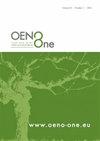叶面矿物质处理对葡萄附生微生物、类黄酮基因表达和浆果成分影响的综合研究
IF 2.2
3区 农林科学
Q3 FOOD SCIENCE & TECHNOLOGY
引用次数: 0
摘要
使用矿物质化合物进行叶面处理是应对葡萄园高温胁迫的一种可持续方法,可在不改变糖分浓度的情况下改善葡萄和葡萄酒的色泽,因此引起了人们的兴趣。由于浆果相关微生物对葡萄酒的生产、成分和稳定性至关重要,本研究旨在揭示高岭土和沸石处理对浆果质量、类黄酮基因表达和附生微生物(总真菌、Hanseniospora uvarum、Metschnikowia pulcherrima、植物相关细菌和乳酸菌)的影响。在两个生长季节(2019 年和 2020 年)的成熟期对 "桑娇维塞 "进行了实验。两种矿物质处理方法都能激发多个类黄酮相关基因,并提高浆果中的花青素浓度,而不会改变葡萄的最终技术成熟度(TSS、TA、pH 值)。有趣的是,尽管在压力较大的年份(2019 年)观察到了短暂的变化,但高岭土和沸石都没有对收获时分析的微生物群产生负面影响。这些结果支持使用叶面矿物质处理来提高葡萄浆果中的花青素浓度,并保护它们免受过热的影响,而不会改变其本地微生物。本文章由计算机程序翻译,如有差异,请以英文原文为准。
A comprehensive study on the effect of foliar mineral treatments on grapevine epiphytic microorganisms, flavonoid gene expression, and berry composition
Foliar treatments with mineral-based compounds have aroused interest as a sustainable approach to cope with high-temperature stress in vineyards, improving the colour of grapes and wines without altering the sugar concentration. Since berry-associated microorganisms are crucial for wine production, composition and stability, the present study aims to unravel the effects of kaolin and zeolite treatments on berry quality, flavonoid gene expression and epiphytic microorganisms (total fungi, Hanseniospora uvarum, Metschnikowia pulcherrima, plant-associated bacteria and lactic acid bacteria). Experiments were performed on 'Sangiovese' during ripening in two growing seasons (2019 and 2020). Both mineral treatments were able to cause the elicitation of several flavonoid-related genes and to increase the anthocyanin concentration in berries without an alteration of the final technological maturity (TSS, TA, pH) of the grapes. Interestingly, neither kaolin nor zeolites negatively affected the analysed microbial population at harvest despite transient alterations observed in the more stressful year (2019). These results support the use of foliar mineral treatments to increase anthocyanin concentration in grape berries and protect them from excessive heat without altering their native microorganisms.
求助全文
通过发布文献求助,成功后即可免费获取论文全文。
去求助
来源期刊

OENO One
Agricultural and Biological Sciences-Food Science
CiteScore
4.40
自引率
13.80%
发文量
85
审稿时长
13 weeks
期刊介绍:
OENO One is a peer-reviewed journal that publishes original research, reviews, mini-reviews, short communications, perspectives and spotlights in the areas of viticulture, grapevine physiology, genomics and genetics, oenology, winemaking technology and processes, wine chemistry and quality, analytical chemistry, microbiology, sensory and consumer sciences, safety and health. OENO One belongs to the International Viticulture and Enology Society - IVES, an academic association dedicated to viticulture and enology.
 求助内容:
求助内容: 应助结果提醒方式:
应助结果提醒方式:


